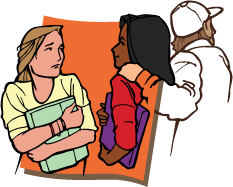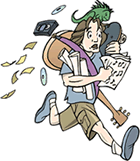Lesson 2.2A: What If You Had No Choice?
 If you were given no choices in your life for what you were to eat, wear, listen to, believe in, or become in your adult life, would you simply agree and be satisfied? Probably not. What happens when we disagree? We grudge, we argue, we refuse, we revolt. We have conflict. Conflict is struggle, and we face conflict whenever we want something to be different. If you were given no choices in your life for what you were to eat, wear, listen to, believe in, or become in your adult life, would you simply agree and be satisfied? Probably not. What happens when we disagree? We grudge, we argue, we refuse, we revolt. We have conflict. Conflict is struggle, and we face conflict whenever we want something to be different.
His Life Is Perfect, Isn’t It?
Do you have an image of the perfect life in your mind? What is it like? What kind of job do you have? What clothes do you wear? Take yourself there for a moment: imagine your happiness. If you had the power to give that kind of life to someone else, would you do it? Would they like it?
Let's look at the life of Warren Pryor, and see if it is anything like the perfect life you imagined for yourself. You have a recorded version of the poem available to you. Poetry is meant to be read aloud, and listened to. Take the time to listen to the poem, before moving on to the guided practice activities.
Tips for Effective Listening
These listening tips will help you to be an effective listener. They are as useful for listening to another person as they are for listening to a recording.
- Choose a comfortable place to listen, where you won't be interrupted. Turn off the TV, the stereo, or other distractions.
- Focus your attention entirely on your listening.
- If your mind begins to wander, take a deep breath and shift your body position so that you can redirect your attention to the listening.
- You can process thoughts much faster than you can listen; take the opportunity to reflect on what you have heard, to notice any repeated elements, or to generate questions.
- Try taking notes or drawing images of important information as you read.
- Think about what you have heard entirely before asking questions or making comments. Then, take time to ask the questions, or to listen again to the recording to uncover the answers.
 Go to Warren Pryor to listen to an audio recording of this poem by Alden Nowlan. Pay attention to the visual images that accompany the poem as you listen: how do the images help you to understand the poem's conflict? Go to Warren Pryor to listen to an audio recording of this poem by Alden Nowlan. Pay attention to the visual images that accompany the poem as you listen: how do the images help you to understand the poem's conflict?
Turn to page 70 in your Sightlines 10 textbook if you want to read along.
Types of Conflict
When we are in disagreement with something, or want something to be different, we have a conflict. The conflict can be internal, struggling within our mind or heart about an issue, or external, struggling with someone or something else.
There are four types of conflict. Under each type are some examples of how the conflict might appear in a story.
 a person in conflictwith himself or herself (internal conflict) a person in conflictwith himself or herself (internal conflict)
- A boy has lied to his mother about taking her money. He can't enjoy the treats he bought himself with the money, and can't decide how to make things right again.
- A young woman, a devoted daughter, wants to travel to England to see her best friend get married; but her sick mother needs her, and she isn't sure what to do.
a person in conflict with another person (externalconflict)
- Sally tells rumors about Andrea. Finally, Andrea confronts Sally in the cafeteria about the lies she has been spreading.
a person in conflict with nature (external conflict)
- Joel knew, now that his climbing harness had broken, that there was no way he could climb off the steep rock face quickly enough to escape the sudden storm that was sweeping across the mountains toward him.
a person in conflict with society (external conflict)
- Even though Tian, a recent immigrant, had a chemical engineering degree, she had to put up with the mocking comments of the café customers who assumed she didn't know anything because she spoke English with a strong Filipino accent.

To learn more about this topic, click on Characters in Conflict .

Journal Entry 2.2A: What Kinds of Conflicts Do You Experience or Encounter in Your Life?
Answer one of the following questions in the journal section of the send in assignment template.
- Have you experienced a conflict recently, or a conflict that you are finding hard to forget? Describe the main idea of the conflict by answering the following questions: Was the conflict internal or external? What were you trying to achieve? What was the resolution or outcome? What did you learn from the conflict?
- Looking around at the people in your life, what kinds of conflicts do you see them experiencing? Provide at least two examples of conflicts that you are aware of around you. For each conflict, label the kind of conflict (from the four types above), sketch an image that symbolizes that conflict, briefly explain the struggle as you see it, and predict what might be the resolution. Explain your prediction.
|
Discussion Prompt |
| Look at a recent newspaper, and list the conflicts discussed on the pages. Fit the conflicts into the four categories of conflict. Is there an example for each type? Which type of conflict is most commonly discussed in the newsp |
Guidelines for contribution:
Record the examples of conflicts. Explain where you would place it, and identify whether the example includes more than one kind of conflict, or is best placed under one type. Click here to add your entry now.
|
 Crisis and Calm Crisis and Calm
If your life were calm all of the time, would it be perfect, or perfectly boring? A life free of conflict might seem like the ultimate dream, but maybe it would be as exciting as riding to the second floor in an empty elevator. On the other hand, a life of constant conflict would be exhausting and difficult; there would be no time to enjoy living.
Because life has periods of tension and periods of tranquility, novels are built on patterns of crisis and calm. The shifting back and forth keeps the novel moving forward. Each crisis moves the main character closer to or farther from his goal, and each period of calm gives the main character a chance to reflect on what is happening.
 While you are reading the next chapters of your novel, notice the conflicts and how often the main character enters a period of crisis, and then a period of calm. While you are reading the next chapters of your novel, notice the conflicts and how often the main character enters a period of crisis, and then a period of calm.
Pick up your novel and read the chapters listed below. This is the longest reading of this module, and will take you almost to the end of the story. Take your time to do this reading, and pause to complete your chapter notes, and wonder about the events in the story as you read.
Read chapters 9 - 14 in your novel The Chrysalids. |
Note: Remember that chapter notes are a helpful way to remember and review what you have read. Complete the notes at the end of each chapter, or every few chapters if they are very short.
|

Journal Entry 2.2B: What is the Main Conflict in the Novel?
Respond to the following questions in the journal section of the assignment tempalte:
- What is the main type of conflict in the novel?
- What main goal is the protagonist trying to achieve?
- Do you think he will succeed? Why or why not?
- Does the protagonist have strengths that he can use to succeed?
- Does the protagonist have weaknesses that keep him from succeeding? Explain.
|
 Go to Writing on the Run! and complete the tutorial and exercises on "Capitalization." Go to Writing on the Run! and complete the tutorial and exercises on "Capitalization."
Summary
Completing this lesson has helped you to:
- list the different sources of conflict in our lives
- identify the three kinds of conflict
- predict the outcome of conflicts you witness in your world
|

